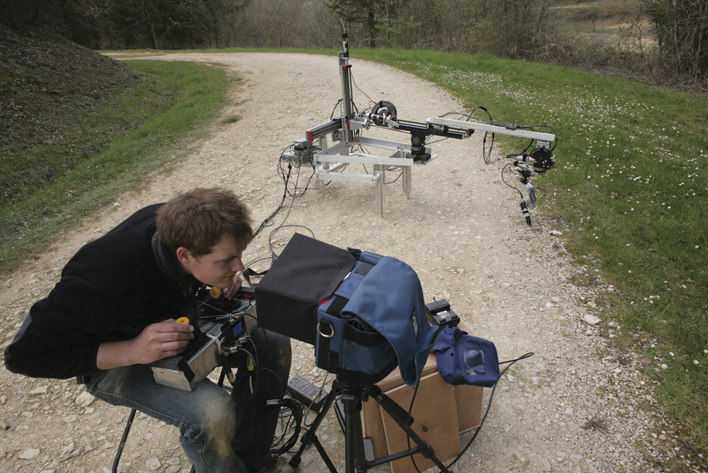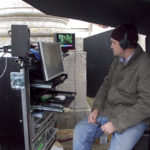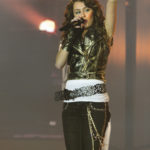
Small Talk Diaries
Posted on May 10, 2010 by Alex Fice
HD Natural World Series aren’t just the preserve of the ‘serious’ Wildlife production. Introducing Small Talk Diaries and their Anthropomorphic attitude to insects – the message is “It’s alright to laugh at animals” – Pictured Frankencam being used to track an ant trail with Iconix attachedPicture Gallery
High Definition wildlife photography was always meant to live on the grand vista and Planet Earth and the like has attuned us to expect glorious sweeps of exotic parts of the world when the words ‘wildlife’ and ‘HD’ are mentioned in the same sentence. Small Talk Diaries is maybe the antithesis of the Planet Earth type programme. Although shot in HD it’s use hasn’t been requested by the broadcaster, CBBC. It is strictly for kids and relies for its main thrust of entertainment on the characterisation of insects with human voices, but a Look Who’s Talking for bugs it isn’t!
Small Talk Diaries is a series of programmes that tells you that it’s OK to laugh at insects because really they are quite funny and giving them eyes and other facial expressions catches your attention and has a touch of ‘education-by-stealth’ about it.
The Bristol-based production company Ammonite had an idea for this humanisation of insects as a basis for a programme a few years ago and it was only when producer Martin Dohrn talked it through with a CGI skilled friend that thing started taking shape.
“Initially it evolved from my own idea, I was interested in having a bit of a laugh and getting some humour in to wildlife filming. I was talking it through with a friend of mine, Rowan McCarthy, who has since gone back to Australia, and we developed it with the idea of silly faces.
“We put some eyes on a woodlouse and we made a little movie called Bug Wars. It was really more for grown-ups than children at that time. We experimented with different styles from good blends of facial features to magazine-like cut-outs – everybody said that they hated the crude cut-outs and loved the blended faces.
“So then another friend of mine Richard Higgs of Big Squid New Media who specialise in compositing and CGI and I got together and took it a step further”.
Martin shot some footage of woodlice with a special endoscope lens that he already had and took it to Richard to put the ‘eyes’ on ‘properly’. Martin and Richard with his team put together the comps and once the eyes were there the magic started: Martin, “A couple of trials later I saw a shot that persuaded me that this was something amazing!”
He put together a script, which was called the Decomposers and made a little six minute film with Big Squid compositing a woodlouse and a worm. “I have a great fear of CGI especially HD CGI because of the amount of money it can cost and the amount of time it can use to make something than can still look like a CGI. My intention was to see whether or not we could do with straight compositing. So we would take a 2D part of a human face and we stick it on a 2D picture then the work is in the tracking and the blending of that. So that was how I was planning to make it affordable in the normal world. In the end we did end up using a lot of CGI eyes which start as 3D then to 2D and are composited normally. They were true 3D renders.”
A grant from South West Screen turned out to be a catalyst for the production as it enabled a more professional-looking promo which in turn produced funding from the Dutch distribution company Off The Fence. “They told us that if we got a commission they would give us this amount of money, I’m not sure if that was because of the South West Screen grant or not. So then we went to the BBC with both those amounts and they said yes.”
At that point they had about a quarter of the Pilot already shot so they had to shoot the rest of it and deliver a show that would excite them. They got the commission but with only 10 percent of the series in the can.
Without a broadcaster asking for high definition from the start Ammonite could have decided to shoot SD or even film but there were some very good reasons for shooting HD and ironically resolution was the least of them: “We used the Varicam for a lot of the footage and it is the best standard definition camera ever built if you know what I mean. It’s very flexible with fantastic picture quality. But the whole thing about SD with our particular post production process which is based on Final Cut Pro makes SD really quite complicated. If you’re using DV it’s very simple but we couldn’t really use DV as we needed to use a proper recording format. I didn’t want to use film for various reasons, we couldn’t technically get the images we wanted on film, we had to use a video format.
“On standard definition there wasn’t a small minicam that had a 16:9 format. We have used the Toshiba TU48 in the past but it is a 4:3 format and we couldn’t really have that for international markets. So if we used DVCPRO HD with Final Cut Pro actually in terms of the post production cost it’s not a lot more than SD and the cameras are all the best quality we can possibly get and all 16:9. It would have probably cost us more to make it on Digibeta if you include all the tape costs and the transfer to DV to edit it. Also DVCAM was ruled out because it just doesn’t have the frequency response to shoot fast moving shots, it just breaks up and falls apart.”
The other big deciding factor was the ability to shoot all day long at 60fps with the Varicam. All of the characters are running around much faster than people really like to watch them so they were able to slow everything down.
The Varicam became the camcorder of choice for the series but by no means the only one because as soon as an Iconix was available it was bought in to work with their main motion control device, creepily called ‘Frankencam’.
“The Varicam does perform better at 720p than the Iconix but the Iconix can go to 1080p which looks fantastic. We have also devised various means of getting the slow motion from either camera losslessly. There are different ways of doing this, some of them ruin the picture completely, that has been the problem with some of the use of Varicam, not knowing how to maintain the quality of the image right to the very end of the post production process.
“Firstly we had a frame rate converter which is actually a very useful device because it’s very fast and enables us to digitise all of our rushes easily and quickly. But we never digitised anything in 720p unless it was through Firewire and if it was a direct, absolute clone of what was on the tape. Otherwise we always digitised in 1080i or 1080p. We’re not so much up converting but rearranging the data in such a way that the quality that is on the original recording stays there. The only drawback of the frame rate converter is that there is a slight loss of quality as you go through it. What we did for Onlining was to digitise off the tape through Firewire so we now have an absolute clone of the tape and we drop that into a Final Cut Pro Motion 60p project and export it as 1080p. Compare that way with a straight frame rate conversion there is a slight improvement of quality going the Motion route but it takes longer.”
Martin has had scope lens systems for a while and he admits that they are in a ‘constant state of evolution’. “We have the Mini Scope which are the smallest possible lenses that I can actually hold in my fingers and then we have the Mega Scope which is bigger. This scope became very much our standard lens because for getting behaviour with big close-ups and getting them quickly it worked surprisingly well. If you’re got some really interesting action say in a clump of grass you might want to use a long macro lens, say a 200mm macro. But the problem with this is that you can’t find anything in the viewfinder because the area you are looking for is so small. With the Mega Scope you can get exactly the same shot very quickly because you just put the lens in front very quickly and you can see where you are. I wasn’t expecting the Mega Scope to be a good as that, and then we put a focus motor on to the Mega Scope itself which meant that for fast moving action we didn’t have to shake the camera and fiddle with the focus, if something jumps forward you can instantly snap the focus forward. It gave us a huge focus range from say half an inch to Infinity in one turn of the hand. So we did put the Mini Scope on the Iconix and then we put that on Frankencam which gave us this extraordinary rotating move. “
If you look at the picture on the opposite page of Frankencam you can see that it’s an extraordinary feat of engineering and seemingly very complicated.
“It has the capacity for movement through six axis but the fifth and sixth aren’t that smooth so it’s easier at the moment to get up and adjust it and then sit down again. It’s got backwards and forwards, left and right, up and down, as well as what we call a swivel so it can rotate around the actual point of the lens. If you’re right next to an ant for instance you can go right round it in a complete circle. Because we’re using these wide angles lenses, around 2mm, in order to get a close-up you have to be right next to the animal. If the animal take two steps to the left you have to move two steps to the left. To do that in any other way would be impossible but with the swivel you just you have this great live feeling of being there with the animals.
“It’s got two joysticks which over the years since we first started took us a while to work out how to use with the different axis without melting your brain trying to figure it out! We’ve now arranged the axis in such a way so it’s quite intuitive and we’ve added some more electronics so that the motors can talk to each other. It’s now more like driving a car inasmuch as if you want to go forward you push the joystick forward and so on. But it’s still quite difficult to drive when you’re dealing with a slight movement of a 1000th of a millimeter showing on the shot. Most of the time we’re not that close.”
Frankencam is mainly for the Iconix camera although you could rig it for Varicam but you’d lose the swivel movement. Martin had to wait two years for Iconix to come along and is still surprised that people aren’t using the camera more: “For what it is it’s pretty cheap really given that it does output 1080/60p but we can’t afford a SRW1 deck to record that. However we’re waiting for the Codex Digital Portable and the new Wafian recorders that can also record in that format.”
So not only are Ammonite trying to invent a new genre of film making which is based on comedic Anthropomorphism in the great and unique style of the late UK animal lover and TV presenter Johnny Morris but also using cutting edge engineering to get close to the insects. The next step is to light the scene when you’ve got the insects where you want them.
“Generally speaking most creatures don’t really like light and so the problem is always trying to get them to behave with light. Your average endoscope for instance is classed at F64 so that shows you how much light you need just to get an image. So when you go up with that much light in front of a woodlouse the chances are that it will run away. But they don’t all run away and sometimes they get used to it and start behaving normally.
“This is one of the main reasons we couldn’t have used film for any of this because the Varicam and Iconix have about three or four more stops of sensitivity compared to even the fastest film stock. For example we used a light called a Joker-Bug which is a fantastic French HMI light that gives you a variety of options in terms of how you spread the light. Essentially the bulb is in a parabolic reflector that if you take all the diffusers and everything else off will throw a perfect circle of extreme intensity light for quite a long way. For us it’s perfect so we could put it 10 feet away and because it’s a point source it would give us something very much like full sunlight in intensity, temperature and sharpness of shadow. To get the same shot on film I would’ve needed at least a 2.5k light.
“Joker-Bug was one of the key things we used, it was very simple to use and just delivered instant daylight. If you had a cloudy day and the animals were not very happy, maybe they were sun loving animals like Wolf Spiders who like to display in the sun, put the Joker-Bug on it and a half orange on the Joker-Bug and turn you colour temperature down a little bit so the light from the grey sky fills in the shadows as blue. The warmth from the Joker-Bug makes the Wolf Spiders think it’s a sunny day so they start displaying, the light is indistinguishable from a sunny day so it gave us extended hours to shoot.”
All the post for Small Talk Diaries was done in-house in Bristol and achieved a now normal process of digitising in DVCPRO HD basically for the reason of the amount of rushes which were to be handled and the desire to keep different formats away.
“While we were shooting in France we brought down a computer and had a variety of people just digitising – for instance one of them was a biologist who found things that we didn’t appreciate were there. We had a kind of rule that ‘Thy shall not digitise thine own material’! So if you shoot something you can’t digitise it.
“I’m sure there are plenty of good shots that didn’t get digitised that should have done but I’m not going to go and look for them. We backed up twice which also meant we had sufficient material to have two editors working and we had a third FCP so we could do 10-bit un-compressed.
“Getting from the offline to the online we had various difficulties which included Time Remap. One of the editors loved this feature but anywhere he used it we had a massive problem in the online, we had to go back and sort it out. We graded it within FCP using Color a little bit but I didn’t find anything with it that FCP didn’t have already and there were very few shots that needed that kind of special measure.
“Matching between the two cameras was an issue and we had to change a couple of shots because they were never going to fit but on the whole it wasn’t that difficult.
“The biggest problem I had was the film which we shot in slow motion on a Photosonics Super 16 camera. That was very hard to get to match either the other two. That was where we found Color very useful.”
Small Talk Diaries is currently being shown on the BBC’s CBBC Channel








